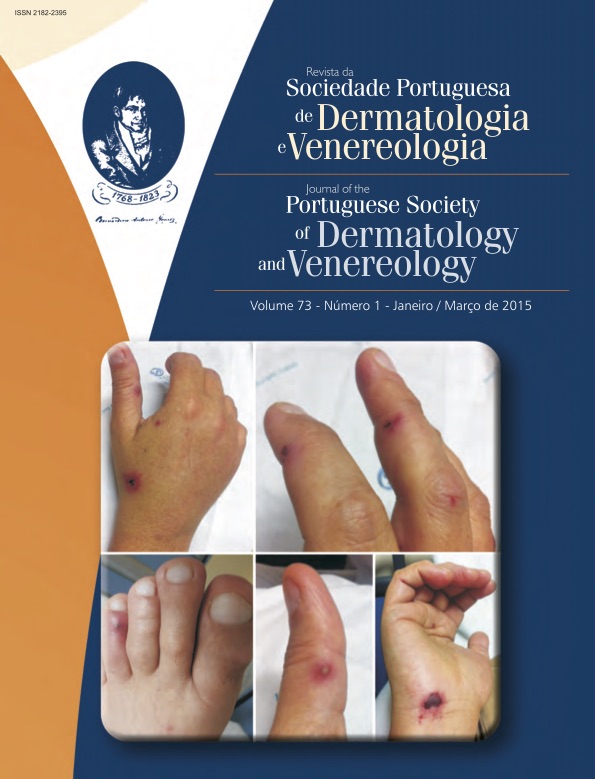FIBROUS HISTIOCYTOMA ARISING ON THE FACE – AN UNEXPECTED DIAGNOSIS
Abstract
Introduction: Fibrous histiocytoma represents a group of common benign lesions that occur mainly on the extremities. The location on the face is rare and here, more aggressive variants and higher local recurrence are described.
Methods: We conducted a retrospective clinicopathological study of cases of fibrous histiocytoma arising on the face at the Dermatology Service of the Hospital Egas Moniz and the “Centro de Dermatologia Médico-Cirúrgica” in Lisbon, between January 2001 and December 2012.
Results: In a total of 1307 fibrous histiocytoma (any location), 12 were located on the face. These lesions occurred in 8 females and 4 males (mean age 48.9 years). The preferred location was the nose (4 cases) followed by the chin (3 cases), interciliar (3 cases), infraorbital (1 case) and ear (1case). The most common clinical diagnosis was epidermoid cyst (5 cases). Histologically, the majority of tumors (10 cases) reached the deep dermis. Six cases showed common morphology. Three cases corresponded to the cellular variant of fibrous histiocytoma, two cases aneurysmal fibrous histiocytoma and one case hemosiderotic fibrous histiocytoma. In five cases mild pleomorphism and mitotic activity were evident. Necrosis, neural and / or vascular invasion were not identified. In seven lesions immunohistochemical studies for differential diagnosis were performed.
Conclusion: In most cases correlation with the clinical diagnosis was not observed. Compared with common fibrous histiocytoma, involvement of deep structures, cell density and pleomorphism are more frequent, leading to a need of greater clinical vigilance and excision with wider safety margins.
Downloads
References
Calonje E. Dermatofibroma (fibrous histiocytoma): an inflammatory or neoplastic disorder? Histopathology.
; 39:213.
Vanni R, Fletcher CD, Sciot R, Dal Cin P, De Wever I, Mandahl N, et al. Cytogenetic evidence of clonality in cutaneous benign fibrous histiocytomas: a report of the CHAMP study group. Histopathology. 2000; 37:212-7.
Hui P, Glusac EJ, Sinard JH, Perkins AS. Clonal analysis of cutaneous fibrous histiocytoma (dermatofibroma). J Cutan Pathol.2002; 29:385-9.
Requena L, Fariña MC, Fuente C, Piqué E, Olivares M, Martín L, et al. Giant dermatofibroma. A little-known clinical variant of dermatofibroma. J Am Acad Dermatol. 1994; 30:714-8.
Numajiri T, Kishimoto S, Shibagaki R, Kuramoto N, Takenaka H, Yasuno H. Giant combined dermatofibroma. Br J Dermatol. 2000; 143:655-7.
Leow LJ, Sinclair PA, Horton JJ. Plaque-like dermatofibroma: A distinct and rare benign neoplasm? Australas J Dermatol. 2008; 49:106-8.
Cohen PR. Multiple dermatofibromas in patients with autoimmune disorders receiving immunosuppressive therapy. Int J Dermatol. 1991; 30:266-70.
Pechere M, Chavaz P, Saurat JH. Multiple eruptive dermatofibromas in an AIDS patient: a new differential
diagnosis of Kaposi's sarcoma. Dermatology 1995; 190:319.
Kanitakis J, Carbonnel E, Delmonte S, Livrozet JM, Faure M, Claudy A. Multiple eruptive dermatofibromas in a patient with HIV infection: case report and literature review. J Cutan Pathol. 2000; 27:54-6.
Bachmeyer C, Cordier F, Blum L, Cazier A, Vérola O, Aractingi S. Multiple eruptive dermatofibromas after highly active antiretroviral therapy. Br J Dermatol. 2000; 143:1336-7.
Calonje E, Fletcher CDM. Cutaneous fibrohistiocytic tumors: an update. Adv Anat Pathol. 1994; 1:2-15.
Iwata J, Fletcher CD. Lipidized fibrous histiocytoma: clinicopathologic analysis of 22 cases. Am J.Dermatopathol. 2000; 22:126-34.
Kuo TT, Hu S, Chan HL. Keloidal dermatofibroma: report of 10 cases of a new variant. Am J Surg Pathol. 1998; 22:564- 8.
Val-Bernal JF, Mira C. Dermatofibroma with granular cells. J Cutan Pathol. 1996; 23; 562-5.
Schwob VS, Santa Cruz DJ. Palisading cutaneous fibrous histiocytoma. J Cutan Pathol. 1986; 13:403-47.
Beer M, Eckert F, Schmoeckel C. Atrophic dermatofibroma. J Am Acad Dermatol. 1991; 25:1081-2.
Wambacher-Gasser B, Zelger B, Zelger BG, Steiner H. Clear cell dermatofibroma. Histopathology. 1997; 30:64-9.
Zelger BG, Zelger B. Myxoid dermatofibroma. Histopathology. 1999; 34:357-64.
Sanchez Yus E, Soria L, de Eusebio E, Requena L. Lichenoid, erosive and ulcerated dermatofibromas. Three additional clinico- pathological variants. J Cutan Pathol. 2000; 27:112-7.
Tran TA, Hayner-Buchan A, Jones DM, McRorie D, Carlson JA. Cutaneous balloon cell dermatofibroma (fibrous histiocytoma).Am J Dermatopathol. 2007; 29:197-200.
Garrido-Ruiz MC, Carrillo R, Enguita AB, Rodriguez Peralto LJ. Signet-ring cell dermatofibroma. Am J Dermatopathol. 2009; 31:84-7.
Kutchemeshi M, Barr RJ, Henderson CD. Dermatofibroma with osteoclast-like giant cells. Am J Dermatopathol.
; 14:397-401.
LeBoit PE, Barr RJ. Smoot-muscle proliferation in dermatofibromas. Am J Dermatopathol. 1994; 16:155-60.
Zelger BW, Zelger BG, Rappersberger K. Prominent myofibroblastic differentiation. A pitfall in the diagnosis of dermatofibroma. Am J Dermatopathol. 1997; 19:138-46.
Spaun E, Zelger B. Dermatofibroma with intracytoplasmic eosinophilic globules: an unusual phenomenon. J Cutan Pathol. 2009; 36:796-8.
Mentzel T, Kutzner H, Rütten A, Hügel H. Benign fibrous histiocytoma (dermatofibroma) of the face: clinicopathologic and immunohistochemical study of 34 cases associated with aggressive clinical course. Am J Dermatopathol. 2001; 23:419-26.
Fletcher CD. Benign fibrous histiocytoma of subcutaneous and deep soft tissue: a clinicopathologic analysis of 21 cases. Am J Surg Pathol. 1990; 14:801-9.
Luzar B, Calonje E. Cutaneous fibrohistiocytic tumours – an update. Histopathology. 2010; 56:148-65.
Calonje E, Mentzel T, Fletcher CD. Cellular benign fibrous histiocytoma. Clinicopathologic analysis of 74 cases of a distinctive variant of cutaneous histiocytoma with frequent recurrence. Am J Surg Pathol. 1994; 18:668-76.
Pereira B, Viana I, Vale E, Claro C, Bordalo O. Histiocitofibroma aneurismático: uma variante rara de uma patologia comum. Rev Soc Port Dermatol Venereol. 2005; 63(3):411-4.
Yang P, Hirose T, Hasegawa T, Seki K, Hizawa K. Aneurysmal fibrous histiocytoma of the skin. A histological, immunohistochemical, and ultrastructural study. Am J Dermatopathol. 1995; 17(2):179-84.
All articles in this journal are Open Access under the Creative Commons Attribution-NonCommercial 4.0 International License (CC BY-NC 4.0).








